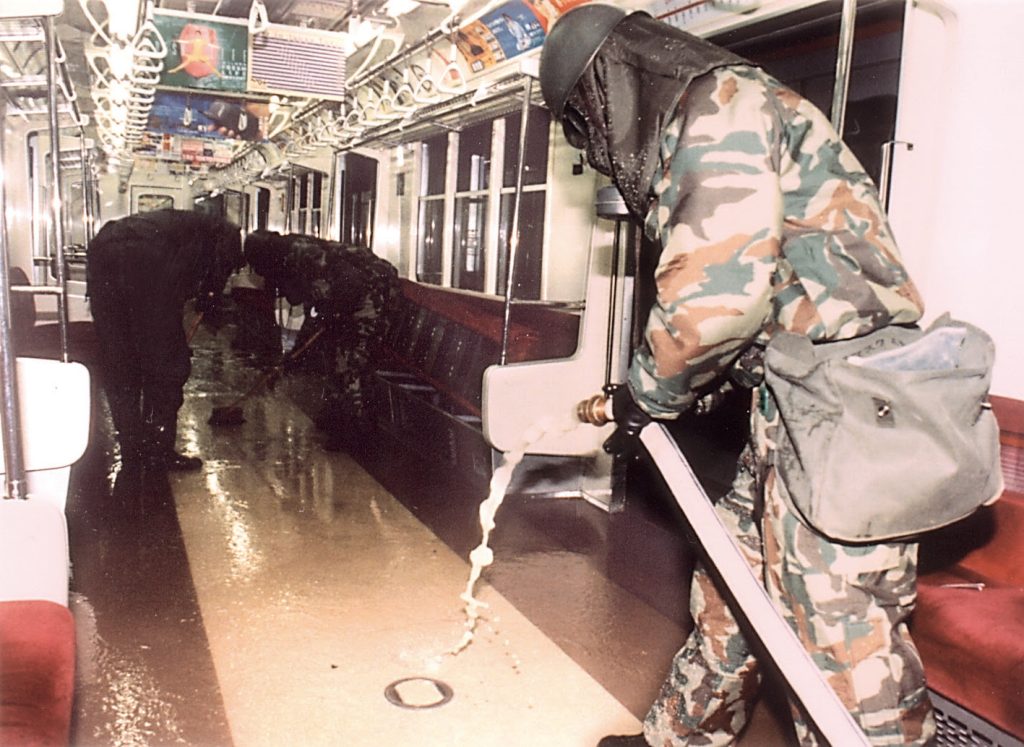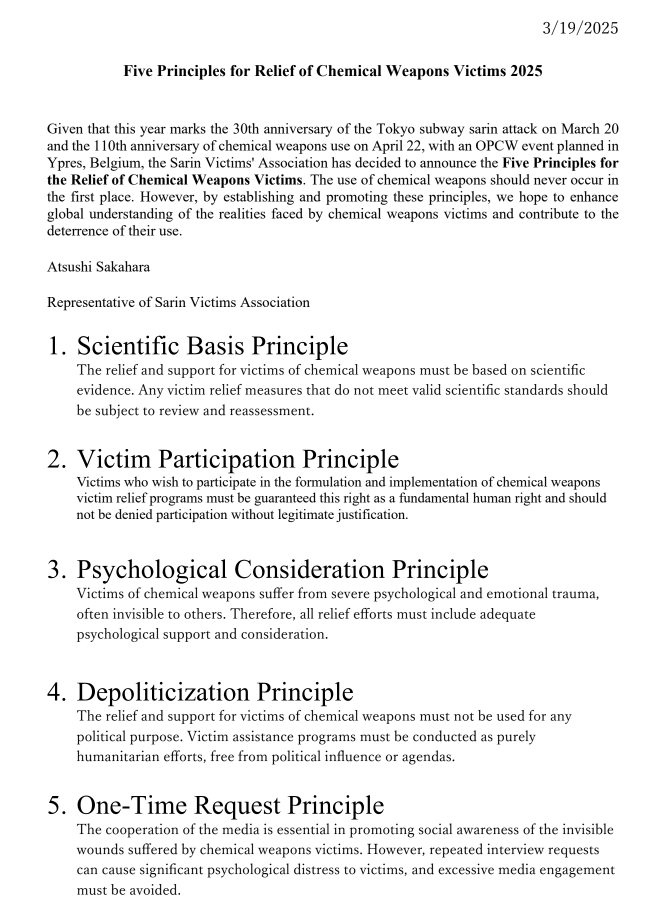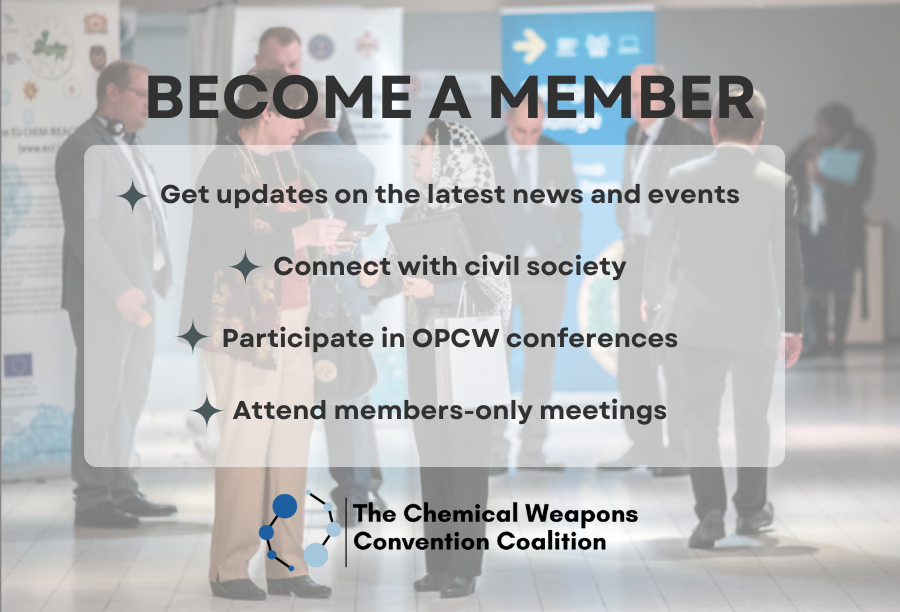Commemorating the 30th Anniversary of the Tokyo Subway Sarin Attack
20 March 2025
The Attack
On 20 March 1995, the Japanese religious organization Aum Shinrikyo perpetrated a terrorist attack by releasing sarin gas, a highly toxic nerve agent, in the Tokyo subway during morning rush hour. The attack left 13 people dead and over 5,000 injured. Thirty years later, victims are still suffering from the physical and psychological injuries of the attack. They also seek to keep the memory of the victims alive and seek compensation for the survivors.
Read more: OPCW: The Sarin Gas Attack in Japan and the Related Forensic Investigation
After the attack, the leader of Aum Shinrikyo and his accomplices were sentenced to prison. They were executed in 2018, but the group continued to operate under new names. A court order required Aum Shinrikyo and its successor, Aleph, to pay more than 1 billion yen in compensation to survivors and their families, but the group has refused to comply. The group continues to be monitored by the Japanese authorities. (Source: 30 years after deadly Rokyo subway gassing, survivors and victims’ families seeking closure, Associated Press, 19 March 2025.)
A commemorative event took place this morning at Tokyo‘s Kasumigaseki Station, the station for which the attacked trains were bound. Victims and their families gathered to remember the victims and offer flowers.

Victims
The exposure to sarin gas has left victims with decades-long physical and psychological health issues. These include eye problems, loss of physical strength, and post-traumatic stress disorders. Mrs. Shizue Takahashi, whose husband was killed in the attack, has worked tirelessly at the forefront of efforts to get compensation for victims and their families and she participates in the annual memorial services at Kasumigaseki Station.
Mr. Atsushi Sakahara, a survivor of the attack and representative of the NGO Sarin Victims Association, released a 5 point plan (below) with recommendations for addressing the needs of victims and survivors. If you are interested in contacting Mr. Sakahara for media inquiries or further information, please reach out to the CWC Coalition.
Mr. Sakahara also recounted his experience in a recent article, “Looking Back on a Day of Terror: Reflections on the Subway Sarin Attacks.”

What is sarin?
Sarin, the type of gas that was used in the attack, is a colorless, odorless nerve agent. Nerve agents are a class of chemical weapon characterized by high toxicity and extreme lethality. They are able to produce deleterious effects in trace amounts, which makes them difficult to detect. |
How does the OPCW address chemical terrorism?
While the Chemical Weapons Convention (CWC) is binding on internationally-recognized nations who make up the States Parties to the Convention, the OPCW actively seeks to prevent the threat of chemical terrorism by non-state actors. States Parties to the CWC can support the prevention of chemical terrorism through the full implementation of the treaty, for example via robust national implementation, thorough export controls, and the adoption of criminal laws that penalize conduct that is prohibited by the treaty.
The OPCW facilitates information and equipment exchanges to ensure emergency preparedness in case a chemical attack were to happen on the soil of a Member State. States Parties can also request assistance from the Technical Secretariat in the event of an attack.
At each meeting of the OPCW Executive Council, the Director-General releases a report on the Status of the OPCW’s Contribution to Global Anti-Terrorism Efforts. Read the most recent statement from 27 February 2025 here.
Read more:
OPCW: Preventing the Re-Emergence of Chemical Weapons
OPCW: The Threat of Chemical Weapons: Use by Non-State Actors
News and research
The following news items represent a non-exhaustive collection of relevant articles. The CWC Coalition strives to provide access to factual, informative news and research and does not necessarily endorse the views expressed.
News
30 years on, victims of Aum Shinrikyo’s sarin attack on Tokyo subway still traumatised, South Morning China Post, 19 March 2025
Survey: Over 80% feel public memory of 1995 Tokyo sarin gas attack fading, NHK, 17 March 2025
Victims of 1995 AUM sarin attack struggling with PTSD, survey shows, Kyodo News, 16 March 2025
Special Website Created 30 Years after Tokyo Subway Sarin Attack, Japan Times, 21 February 2025
Reports and studies
Effects of Sarin on the Nervous System of Subway Workers Seven Years after the Tokyo Subway Sarin Attack, Journal of Occupational Health, 12 August 2005
The Tokyo subway sarin attack has long-term effects on survivors: A 10-year study started 5 years after the terrorist incident, PLOS One, 23 June 2020
